Home security is an important concern for many homeowners around the country. Arlo provides a whole suite of home security devices. The most famous are the Arlo security cameras. When the Arlo Ultra was released, it was deemed to be one of the best cameras on the market. There were some issues, though, and sales didn’t match the hopes of the company.
Since, they have released the Arlo Pro 3, a slight downgrade to the Arlo Ultra. How do the two compare? This Arlo review will examine the differences and similarities of the Arlo Pro 3 and Arlo Ultra and answer that question for you. The Arlo Pro 3 is the better option for many. Read on to find out if it is the better option for you.
Contents
Differences between Arlo Pro 3 and Arlo Ultra
Because the Arlo Pro 3 was designed as a middle-ground camera system, it has more market appeal than the Arlo Ultra. Let’s look at the features and options where the two differ.
- The Arlo Ultra records in 4k UHD resolution, while the Arlo Pro 3 records in 2k HD resolution.
- Field of View. The Pro 3 has a horizontal field of view angle of 160 degrees. The Ultra has a wide-angle 180-degree field of view.
- The Arlo Ultra uses dual microphones to improve two-way communications. The Arlo Pro 3 only has a single internal microphone.
- Auto-Zoom & Tracking. The Ultra will automatically zoom and follow motion alerts in the field of view. The Pro 3 does not track or auto-zoom.
Similarities between Arlo Pro 3 and Arlo Ultra
Almost every other aspect, feature, and option are the same between the Pro 3 and Ultra. Here are the important features that are the same.
[easyazon_image align=”center” height=”333″ identifier=”B07JJJJCVP” locale=”US” src=”https://smartrobotichome.com/wp-content/uploads/2019/12/21kqQyk7jrL.jpg” tag=”srh-easyazon-20″ width=”500″]- Magnetic charging. Both models use the magnetic charging cable to allow battery recharging cycles without removing the batteries.
- Dual power options. With the magnetic charging cable, you can run the cameras on battery power or with the cable attached.
- Continuous recordings. Both models offer you the ability to run continuous recordings around the clock.
- Mobile app and WiFi connections. You are able to use the Arlo mobile app and your home wireless network for control and communication with either the Pro 3 or the Ultra.
- Smart home integration. You will be able to connect other smart home devices to the cameras, including Alexa, Google, and Apple HomeKit.
- Two-way communications. Each camera is capable of using two-way communications to see, hear, and talk to whoever is in view.
- Sirens and spotlights. Both the Arlo Ultra and Arlo Pro 3 have sirens and a spotlight built into the cameras.
- Live view. You can use Alexa devices such as the Echo Show to view a live feed of your cameras (you can use the mobile app as well).
Specifications Chart
How do the two models stack up side by side? Let’s have a quick look.
| Arlo Ultra | Arlo Pro 3 | |
| Battery | Magnetic Charging | Magnetic Charging |
| Battery Life | 6 months | 6 months |
| Power Options | Battery, Hardwired | Battery, Hardwired |
| Outdoor Mount | Yes | Yes |
| Operating Temperatures | -4 – 113 degrees F | -4 to 113 degrees F |
| Continuous Recordings | Yes | Yes |
| WiFi | Yes | Yes |
| Mobile App | Yes | Yes |
| Voice Commands | Yes | Yes |
| Smart Home Integration | Yes | Yes |
| Night Vision | Yes | Yes |
| Resolution | 4K | 2k |
| Field of View | 180 degrees | 160 degrees |
| Motion Detection | Yes | Yes |
| Scheduling | Yes | Yes |
| 2-Way Communication | Yes | Yes |
| Live View | Yes | Yes |
| Storage | Yes | Yes |
| USB Backup | Yes | Yes |
| Siren | Yes | Yes |
| Price | Check on Amazon | Check on Amazon |
Comparing the Arlo Pro 3 and the Arlo Ultra
I will just come right out and say it because no one else will. The Arlo Ultra system is fantastic. It is impressive in quality, durability, ease of use, and installation. It is also too much. In a corporate setting, or a commercial setting, it may be perfect. However, if you are looking to protect your home or your parent’s home, it is a bit of overkill.
I quietly suspect that Arlo realized this as well, and it is why they developed the Arlo Pro 3. I can’t speak to that in any professional sense; it is just a hunch. However, many people have found the Arlo Ultra to be the best option for their needs. So let’s see how the two models stack up against each other so you can decide for yourself.
Installation is a Breeze
The installation of the Arlo camera systems is simple. It is so easy, in fact, it could be done without instructions and just a little forethought. You will need access to your internet modem, the Arlo app, and, of course, the cameras.
I will cover the basic steps here so you get an idea of how to set up and install the systems. Your owner’s manual will have detailed, step-by-step instructions for you.
- Connect the hub to the modem with the provided Ethernet cable and connect the power supply from the AC adapter to the hub. Power on the hub.
- Download, install and sign into the Arlo App.
- The app will search for the hub and, once found, will prompt you through the connection and setup process.
- Power on the camera by inserting the batteries.
- Press the sync button on the hub and the button on the camera to connect the camera to the hub.
- Once successful, the mobile app will show the video feed on your phone screen.
- Check that everything is working correctly and that you can see the live feed from the camera.
- Find your installation point and place the camera there to ensure the wireless signal reaches the hub and the mobile app still shows the live feed.
- Install the camera mount using the screws provided.
- Attach the camera to the mount, adjusting the view using the live feed on the mobile app.
You can find more detailed information in your owner’s manual or by watching this installation video. https://www.youtube.com/watch?v=RrnU4CGntRA
Bottom Line: Installation is almost identical for all Arlo cameras, including the Arlo Pro 3 and Arlo Ultra.
Power options – Wired or Wireless?
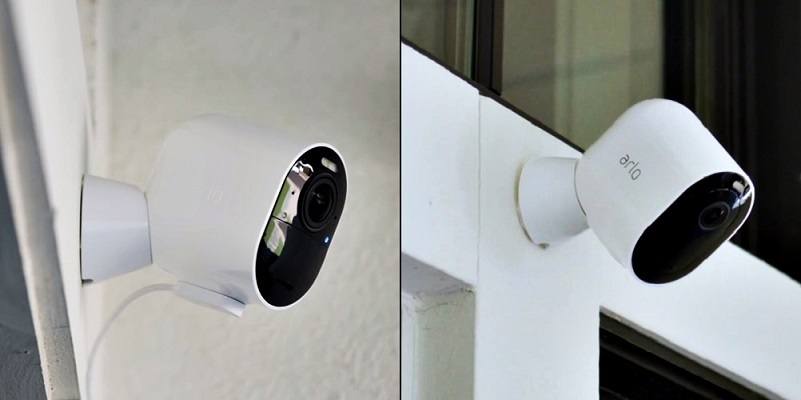
For all practical uses, the cameras are wireless. The magnetic charging cable attaches to the bottom of the camera and charges the battery through the camera body. Unlike previous models where there was a USB connection that required you to move, remove or disassemble the camera to charge the batteries, the cameras can stay on the mounts.
However, you can leave the magnetic charger attached to place a charge on the batteries automatically when they get low. With this ability comes the claim of a hardwired installation. Because the cable is always attached, it means you have a wired camera.
With the wireless cameras, though, you can mount them anywhere, indoors or out. When mounting outdoors (which they were primarily designed for), you will be required to keep them in close range to the wired charging cable. This can pose a problem if you have the cameras far from the house or on a side without an external outlet.
While the magnetic charging does make the charging cycle itself easier, it becomes more problematic to charge the cameras, the further they are from a power supply. The simple answer is to remove the camera from the mount, bring it inside and charge before putting it back on the mount.
Bottom Line: Both models claim to have hardwired and wireless power options, though the reality is that it is either wireless charging or wired charging.
Camera Features and Specifications
The cameras themselves have a couple of upgrades and advanced features that you should know about. First, compared to the earlier Pro models, the design of the Ultra and Pro 3 are more sleek and refined.
Aesthetics aside, both cameras come with a built-in spotlight. No other Arlo camera has a spotlight. The lights are LED and can be activated manually through the mobile app, or you can set it up to have the lights turn on when motion is detected, and recording begins.
There is even a feature that allows you to change the white LED spotlight into a red, blinking light that mimics a video recording. Both the Ultra and Pro 3 have all the spotlight features and uses.
Two-Way Communications and Sirens Have Changed
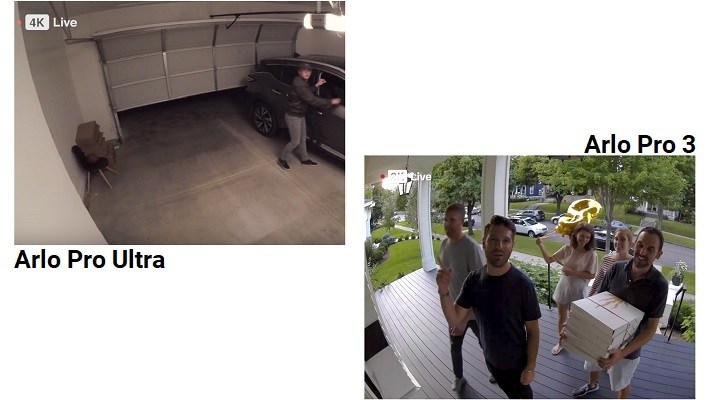
They also both have two-way communications. There is a built-in speaker in each camera that allows whoever is in view to hear you as you speak into the mobile app. The would-be intruder can also respond using the microphones in the cameras.
This is where there is a difference, though. The Arlo Ultra has two microphones in the camera to better pick up audible responses. The Arlo Pro 3 (and all other Arlo Pro cameras for that matter) house a single microphone.
Unless there is a lot of background noise, though, the audio is about the same. While the Arlo Ultra does pick it up better, by the time it is translated and pushed through the speaker on your smartphone, the quality varies.
A lot will also depend on the speaker quality of your phone. In the end, the dual microphones are a nice touch but can be ultimately pointless.
In previous versions, the audible siren was embedded in the hub, which sits inside your home. It was used as an alert for you that the camera had detected motion and was recording. If the intruder made it inside, you could also manually activate the siren through the app as a warning.
With the Pro 3 and Ultra models, the siren has been moved to the camera itself instead of the hub. Now, the 100dB siren will act as a deterrent to would-be intruders. You can still activate the siren manually or set it up to go off when motion is detected.
Video Resolution is the Big Difference
The video resolution is also key. Most security cameras record in high definition, usually at 720p or 1080p. The Arlo Ultra, though, records in full 4k UHD. Part of the issue with that, though, is that not everyone that owns a security system owns a 4k capable viewing device. Computer monitors, tablets, and cell phones do have 4k capabilities now, but they are still uncommon in everyday life.
The Arlo Pro 3 lowered the recording resolution to help this issue as well as keep the overall cost down so more homeowners could afford to install the system. The Pro 3 records in 2k UHD, which can be viewed on most devices with 1080p capabilities.
The recording resolution has a lot more to do with the live streaming and local storage options, which I will cover shortly. For the viewing, though, if you don’t have a 4k capable mobile phone, you won’t get the full benefit of the feature you are paying for. This makes the Pro 3 more appealing.
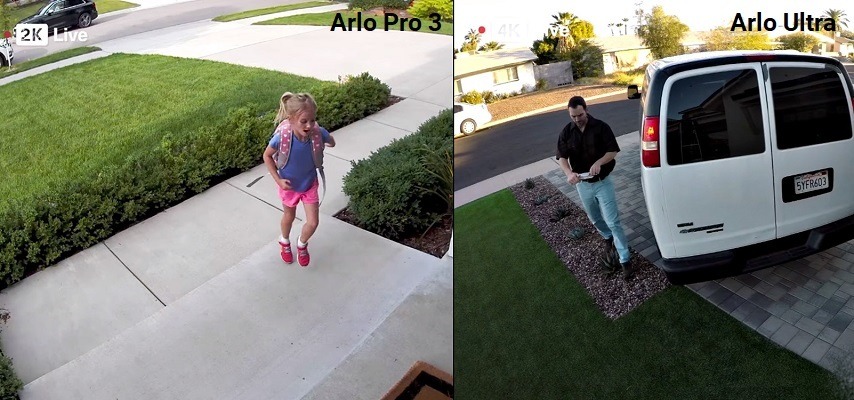
Bottom Line: With little differences between the two cameras in their warning and recording abilities, the choice comes down to the resolution.
The New SmartHub and Local Storage
When the Arlo Ultra was released, it came with a new hub, called the SmartHub. Arlo has always been know as a backward-compatible company, and you can theoretically use any of their cameras with any of their hubs. The Ultra changed that. The Arlo Ultra is only compatible with the SmartHub.
The Arlo Pro 3 also uses the SmartHub. However, it is compatible with most of the previous hub versions as well. Unless you have an older hub model below the VMB4000, you can purchase just the Pro 3 cameras and they will sync with your hub. You can see the full compatibility list here.
You will miss a lot of the newer features, though. The SmartHub will run any Arlo camera, which is nice. It also features compatibility with Z-Wave and ZigBee integration devices, something no previous hub cold offer.
The soon-to-be-released Arlo Home Security System will also use the SmartHub, so if you get it first, you will be a step ahead. The Smarthub also uses ArloRF, which is just a title given to the updated radio frequency used by the hub for communications. The ArloRF extends the WiFi capabilities to allow you to get a strong signal at the cameras further from the base.
The biggest feature upgrade might be the local storage, though. Especially if you plan to live stream in UHD, the local storage will be crucial. Previous hubs used a USB dongle with a limited capacity rating. Now, you can use a MicroSD card with a capacity of up to 1TB of storage space. Since 2k and 4k resolution records can eat up storage space quickly, the extra local storage option is going to come in handy.
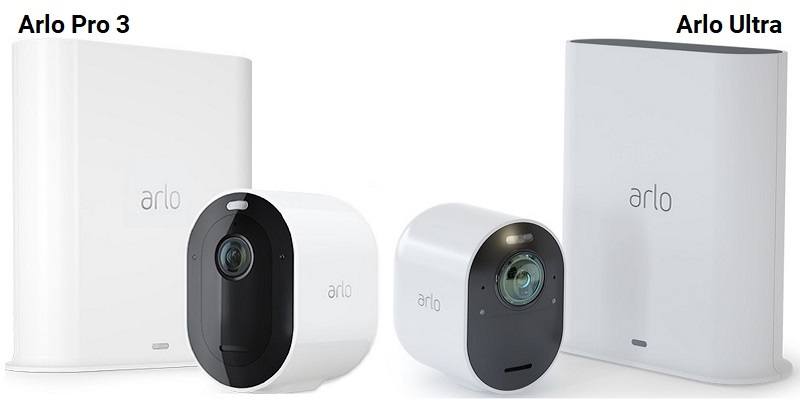
Bottom Line: The Arlo Pro 3 has a slight advantage because it can use the new SmartHub and all its features, just like the Arlo Ultra. However, it is also backward compatible with older Hub models.
Cloud Storage is a bit Different from Past Camera Systems
The Arlo cloud storage and security service (known as Arlo Smart) is a paid subscription. The Arlo Pro 3 and Arlo Ultra are not eligible for the Arlo Smart 7-day rolling free plan. This is due to the high resolution and amount of space a recording requires.
What do you get with an Arlo Smart plan? Well, a lot depends on what plan you go with, and whether you opt for any additional services. The process uses to be simple. Pick one of two payment options and then decide to pay monthly or annually.
Now that the 2k and 4k Arlo cameras are out, the Arlo Smart plans have had to undergo a few changes. I will try to simplify the choices.
Arlo Smart offers you 30-day roll-over recordings, advanced AI detection, customized activity zones, and mobile app lock screen notifications. You get this for $3 per month, per camera.
The Arlo Premier plan gives you everything from the Arlo Smart plan above, plus e911 emergency calling services. This plan costs $10 per month for up to 10 cameras.
The Arlo Smart Elite plan gives you everything from the Premier plan, plus you get 60 days of roll-over recordings, for a price of $15 per month for up to 20 cameras.
For the Arlo Ultra cameras, you can also opt to pay for the Premium Video Recording, which allows you to stream, record, and upload in full 4k, as well as view, save and download clips from anywhere. This costs an extra $2 per month, per camera. It is offered only or the Arlo Ultra cameras, though.
With the Arlo Ultra, you can also add on an additional service that allows you to record directly to the cloud 24 hours a day, 7 days a week. This will cost you an additional $10 per month per camera for a 14-day cycle, and $20 per camera per month for a 28-day cycle.
It should be noted that because you don’t get the Arlo Smart Free plan (7-days roll-over recording), the Arlo Pro 3 comes with a 30-day trial to Arlo Smart Premier, while the Arlo Ultra gives you a full year for free. At the end of these trials, you will need to pay to continue the service.
You can get more details and information on the Arlo Smart page.
Bottom Line: The Arlo Ultra has more available features, but the costs add up quickly. The winner is the camera system you deem is best for your needs and budget.
Frequently Asked Questions
Now I will answer some of the most frequently asked questions about the Arlo Pro 3 and Arlo Ultra camera systems as well as Arlo in general.
Q. What kind of warranty do I get with the Arlo cameras?
A. Each Arlo camera will carry a 1-year limited warranty that starts from the day of purchase. It will cover defects, craftsmanship, and internal damage from normal wear and tear. The warranty will not cover damage from shipping, misuse, or neglect. There are also special provisions that you must adhere to to make a warranty claim. You should read the “Your Responsibilities” section of the warranty service before you purchase.
Q. How do I contact Arlo customer service?
A. Arlo customer support (technical and warranty claim support) are available by phone 24 hours a day, 7 days a week. You can call them at 1-408-638-3750. For all other departments, presales services, or other non-technical inquiries (such as return status, etc.), you can call 1-866-703-7170 between the hours of 6 am and 6 pm PST Monday through Friday.
Q. What is field of view and how does it affect what I can see?
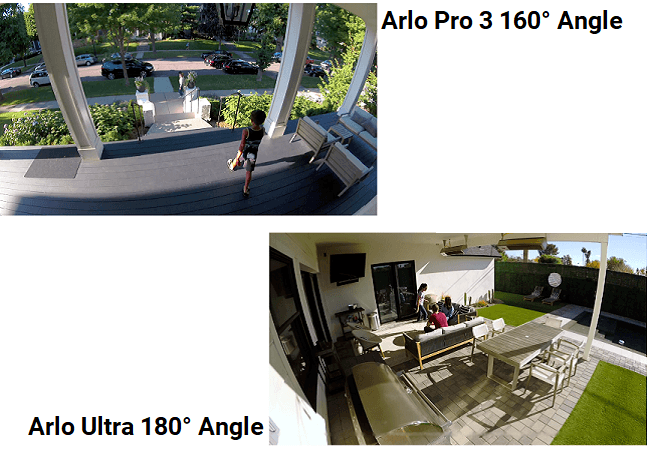
A. Field of view is generally measured in degrees and can be horizontal, vertical, or both — Arlo measures in horizontal views, which is how wide of an angle the camera can see. The larger the field of view, the more area you can see in a single shot. The Arlo Pro 3 has a field of view angle of 160 degrees, while the Arlo Ultra is slightly better with a 180-degree field of view.
Q. Where can I download the Arlo app?
A. There are two apps, and you can only use one of them. As Arlo attempts to get further away from the parent company Netgear, they have updated and released a new app, simply named Arlo. The Arlo Legacy app is no longer used, supported, or updated. It became defunct as of September 30th, 2019. The new app can be downloaded for free from the iOS app store or from the Google Play store.
Q. What is HDR and which cameras offer it?
A. Simply put, HDR is an acronym for High Dynamic Range. What this is, is a feature that clarifies images by boosting brights and darkening darks. It makes colors more vibrant and prevents “wash-out” due to ambient lighting. When recording in 2k and 4k, the images aren’t subject to as much color wash or motion blur when HDR is involved.
What I Like About Arlo Pro 3
- SmartHub and Pro Hub compatible.
- Spotlight and siren in camera.
- Quick and simple DIY install and setup.
What I Like About Arlo Ultra
- Dual microphones to help audible clarity during two-way communications.
- Multiple cloud storage options, including continuous recording (extra monthly fees).
- Magnetic battery charging.
Conclusion
Arlo Ultra is a camera system that is incredible on all fronts. From color night vision to ear-piercing sirens, the Ultra is one that will stand the test of time. However, the 4k resolution, higher price tag, and incompatibility with older Arlo hubs makes it less than desirable to some owners.
The Arlo Pro 3, on the other hand, reduces the resolution to 2k, keeps the additional SmartHub features, sirens, and spotlights and makes the entire system backward compatible. In addition to all of that, the lower price tag makes it more than qualified to take over the top spot in the Arlo line-up, which it does. If you want an affordable, future-proof system, the Arlo Pro 3 is the way to go.
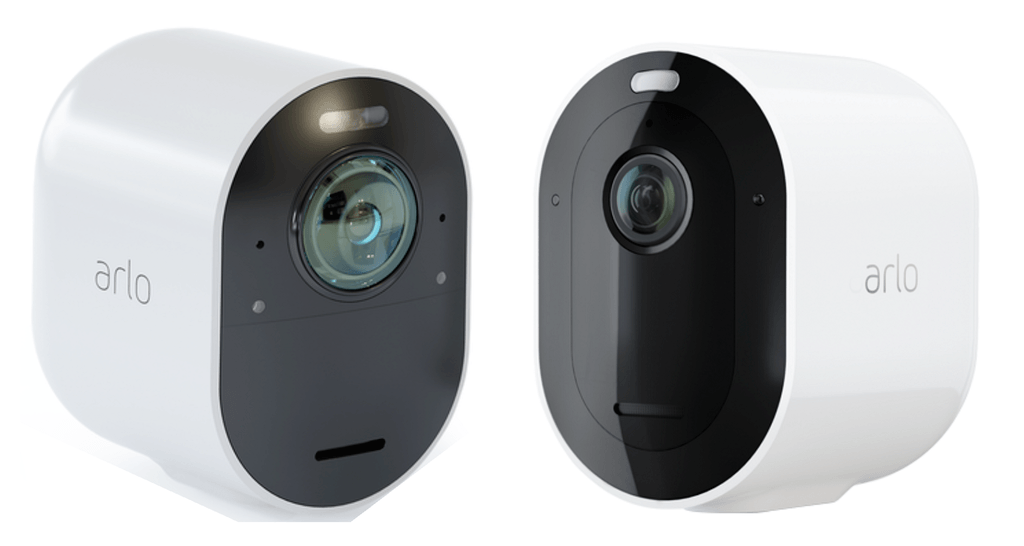
My Arlo Pro 3 System also auto zooms and tracks.